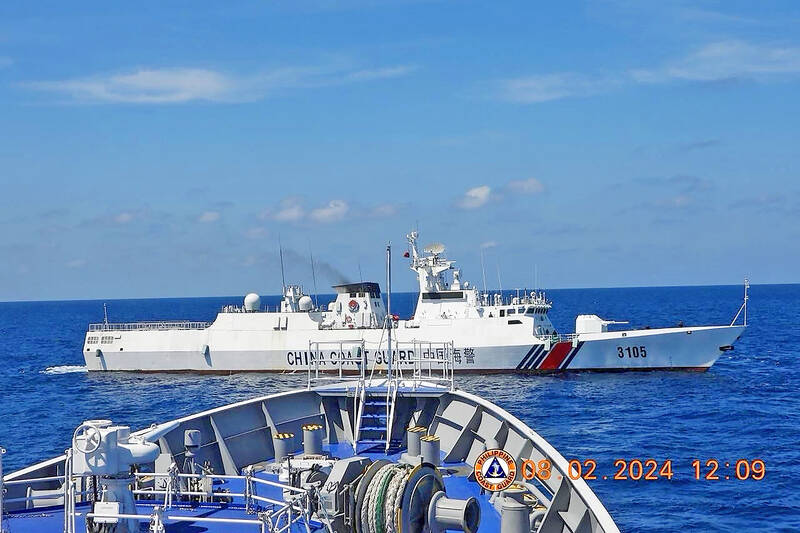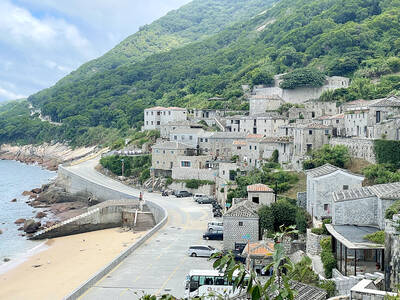Taiwan should form a trilateral security front with the Philippines and Japan through maritime cooperation, humanitarian aid and arms trade, Taiwanese academics said.
The likelihood of an alliance with Japan and the Philippines gained traction after Minister of Foreign Affairs Lin Chia-lung (林佳龍) last month paid low-profile visits to the countries.
Even more discussion of the concept followed the transit of Canadian and Australian military vessels through the Taiwan Strait on Saturday, after the nations participated in joint military drills with the Philippines in the South China Sea.

Photo: Philippine Coast Guard via AFP
National Taiwan University political science associate professor Chen Shih-min (陳世民) over the weekend said that the Philippines, a major non-NATO ally of the US, has in the past few years deepened cooperation with Japan, India, Australia, Canada and Vietnam, which showed that Manila is seeking to integrate the regional security network, a significant development for Taiwan.
Although the absence of a bilateral diplomatic relationship makes it difficult for Taiwan to publicly engage in joint military drills with the Philippines, the government can still leverage Manila’s hardline attitude toward China under Philippine President Ferdinand Marcos Jr over the next two years to step up pragmatic cooperation in security, Chen said.
The Philippines is highly aware of Taiwan being an inseparable part of the regional security chain and might revise its “one China” policy amid increasing pressure from Beijing, he said.
Therefore, Taiwan should take a more proactive role in deepening political and security exchanges with the Philippines, Chen added.
Institute for National Defense and Security Research associate researcher Shu Hsiao-huang (舒孝煌) said that common ground on countering Chinese threats opens room for cooperation among Taiwan, Japan and the Philippines.
However, such cooperation is limited in public, given the political sensitivity, he said, adding that the nations would have to focus on undisclosed dialogues and pragmatic actions.
If Taiwan advances its drone and ammunition industries, it can provide arms for the Philippines at a suitable time to enhance bilateral cooperation, Shu said.
Taiwan should also continue to offer humanitarian aid to the Philippines during disasters to cement mutual trust, he added.
Taiwan National Security Institute deputy secretary-general Ho Cheng-hui (何澄輝) said that Taiwan can start with maritime cooperation, particularly maritime patrol training, to form trilateral cooperation.
Japan has already assisted the Philippines in building patrol vessels and training military personnel, he said.
The BRP Suluan, a Philippine Coast Guard Parola-class patrol vessel, was built by Japan, Ho said.
A China Coast Guard ship and a Chinese navy destroyer collided while trying to block the Suluan near Scarborough Shoal (Huangyan Island, 黃岩島) on Aug. 11.
Joint maritime training and drills by Taiwan, Japan and the Philippines, as well as trilateral joint maritime law enforcement, would help address Beijing’s “gray zone” activities and provocative moves by China’s maritime militia, he said.
Taiwan should leverage partner countries’ demand for a “non-red” supply chain to participate in negotiations and discussions, Ho added.
Once Taiwan has fully developed medium-sized or large uncrewed vehicles, they can be used by the Philippines for maritime supply and the transportation of medical supplies, opening bilateral cooperation, he said.
Taiwan should revise regulations to remove obstacles to foreign investments in the defense industry, and obtain exportation permission for sensitive weapons from Japan to firm up bilateral cooperation, he added.

The Chinese military has built landing bridge ships designed to expand its amphibious options for a potential assault on Taiwan, but their combat effectiveness is limited due to their high vulnerability, a defense expert said in an analysis published on Monday. Shen Ming-shih (沈明室), a research fellow at the Institute for National Defense and Security Research, said that the deployment of such vessels as part of the Chinese People’s Liberation Army (PLA) Navy’s East Sea Fleet signals a strong focus on Taiwan. However, the ships are highly vulnerable to precision strikes, which means they could be destroyed before they achieve their intended

The first two F-16V Bock 70 jets purchased from the US are expected to arrive in Taiwan around Double Ten National Day, which is on Oct. 10, a military source said yesterday. Of the 66 F-16V Block 70 jets purchased from the US, the first completed production in March, the source said, adding that since then three jets have been produced per month. Although there were reports of engine defects, the issue has been resolved, they said. After the jets arrive in Taiwan, they must first pass testing by the air force before they would officially become Taiwan’s property, they said. The air force

GLOBAL: Although Matsu has limited capacity for large numbers of domestic tourists, it would be a great high-end destination for international travelers, an official said Lienchiang County’s (Matsu) unique landscape and Cold War history give it great potential to be marketed as a destination for international travelers, Tourism Administration Director General Chen Yu-hsiu (陳玉秀) said at the weekend. Tourism officials traveled to the outlying island for the Matsu Biennial, an art festival that started on Friday to celebrate Matsu’s culture, history and landscape. Travelers to Matsu, which lies about 190km northwest of Taipei, must fly or take the state-run New Taima passenger ship. However, flights are often canceled during fog season from April to June. Chen spoke about her vision to promote Matsu as a tourist attraction in

PAWSITIVE IMPACT: A shop owner said that while he adopted cats to take care of rodents, they have also attracted younger visitors who also buy his dried goods In Taipei’s Dadaocheng (大稻埕), cats lounging in shops along Dihua Street do more than nap amid the scent of dried seafood. Many have become beloved fixtures who double as photography models, attracting visitors and helping boost sales in one of the capital’s most historic quarters. A recent photo contest featuring more than a dozen shop cats drew more than 2,200 submissions, turning everyday cat-spotting into a friendly competition that attracted amateur and professional photographers. “It’s rare to see cats standing, so when it suddenly did, it felt like a lucky cat,” said Sabrina Hsu (徐淳蔚), who won the NT$10,000 top prize in